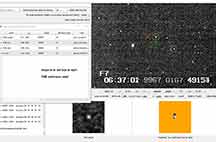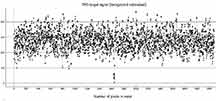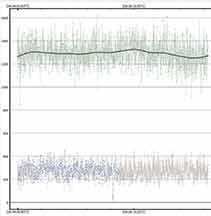


This event path is good rank, and includes both me, and (better) Kirk at home. Karl's too far outside the path to have much chance. The weather is supposed to be party cloudy so I'd better make a webpage before there's last-second clearing and scramble. The alt=54 Az=274 just a degree or so left of M37 star cluster, left of the main "Pentagon" of Auriga.
Duration is only 0.8 seconds, which makes me think I should try to get south of Kirk, to get this long enough to be a clear event. I'm a little uncomfortably too close to the northern limit. So I may try from the entrance to Natural Bridges, which has a good dark view of the west.
 |
 |
 |
Kirk and I both got positives on this short event.
Richard Nolthenius
I observed from the base of my driveway. Used 4x, under clear skies and good conditions. I used TME apertures to minimize sky noise here in downtown Santa Cruz with a large moon low in the east.
magDrop report: percentDrop: 85.8 magDrop: 2.120 +/- 0.318 (0.95 ci)
DNR: 4.15
D time: [06:35:56.2772]
D: 0.6800 containment intervals: {+/- 0.0120} seconds
D: 0.9500 containment intervals: {+/- 0.0312} seconds
D: 0.9973 containment intervals: {+/- 0.0609} seconds
R time: [06:35:56.8125]
R: 0.6800 containment intervals: {+/- 0.0120} seconds
R: 0.9500 containment intervals: {+/- 0.0312} seconds
R: 0.9973 containment intervals: {+/- 0.0609} seconds
Duration (R - D): 0.5353 seconds
Duration: 0.6800 containment intervals: {+/- 0.0179} seconds
Duration: 0.9500 containment intervals: {+/- 0.0399} seconds
Duration: 0.9973 containment intervals: {+/- 0.0720} seconds
 |
 |
 |
 |
 |
 |
Kirk recorded at 2x, from home.
Duration: 0.9973 containment intervals: {+/- 0.4020} seconds
 |
 |
 |
 |
Comments from RN
Kirk was closer to the predicted centerline and had a longer event than I did, so that aspect seems reasonable. He has a curious mid-event rise in brightness which I figure must be noise since there seems no other explanation, given that across town, my own data shows a clean well-behaved occultation profile. Kirk's equipment is good quality and so it's meaningful that his timing accuracies are lower than mine, even though I had a coarser time resolution; 2x for Kirk was a resolution of 1/30s, and my 4x was 1/12.5 s. In the recent past I've emphasized the need for more points to get a good significance on the FP test. This event lasted long enough to get it done despite the faint star, but not by much. My event was shorter than Kirk's at 0.53s and yet much stronger FP test. What I notice in Kirk's target light curve from PyMovie is the large point-to-point scatter in photometry. It would be good in such cases to try a small circular aperture but which includes all starlight. TME apertures typically do not include every last star photon, but exclude sky noise better. The last thing to try, is to include a flat field to help with differing pixel sensitivity.
It's trade-offs and which works best in a given occultation isn't always clear. It's a bit surprising, but with my older setup - an NTSC EIA Watec 910hx/rc - Kirk's data was nearly always better than mine. Smaller scatter, less small scale light curve wandering. His camera doesn't suffer near as much from the clear vertical column noise banding that my older setup had. Vertical column noise does seem to be generic in the Watec cameras, but it is much less in Kirk's (newer) camera than in mine (same version but a bit older). When I bought a new Watec 910hx PAL in 2023, the vertical column noise is also much much less in this new camera than my old. There's a feature in PyMovie that lets you do median noise filtering in horizontal and/or vertical, which does help. But, the noise is only reduced some. I used that feature regularly and still, Kirk's data was nearly always better than mine. Sometimes it was make/or/break and my data didn't get over the bar of the false positive test. With my new PAL camera, our relative data quality comparison places seem to have switched. While the new PAL camera has 20% more signal per equivalent integration setting (1/25s vs 1/30s), it also has fewer points per time period, so I don't think this is the major reason. Perhaps Watec continues to make little manufacturing tweeks and their quality is still improving.